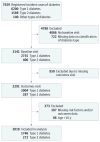Association of Type 1 Diabetes vs Type 2 Diabetes Diagnosed During Childhood and Adolescence With Complications During Teenage Years and Young Adulthood
- PMID: 28245334
- PMCID: PMC5483855
- DOI: 10.1001/jama.2017.0686
Association of Type 1 Diabetes vs Type 2 Diabetes Diagnosed During Childhood and Adolescence With Complications During Teenage Years and Young Adulthood
Abstract
Importance: The burden and determinants of complications and comorbidities in contemporary youth-onset diabetes are unknown.
Objective: To determine the prevalence of and risk factors for complications related to type 1 diabetes vs type 2 diabetes among teenagers and young adults who had been diagnosed with diabetes during childhood and adolescence.
Design, setting, and participants: Observational study from 2002 to 2015 in 5 US locations, including 2018 participants with type 1 and type 2 diabetes diagnosed at younger than 20 years, with single outcome measures between 2011 and 2015.
Exposures: Type 1 and type 2 diabetes and established risk factors (hemoglobin A1c level, body mass index, waist-height ratio, and mean arterial blood pressure).
Main outcomes and measures: Diabetic kidney disease, retinopathy, peripheral neuropathy, cardiovascular autonomic neuropathy, arterial stiffness, and hypertension.
Results: Of 2018 participants, 1746 had type 1 diabetes (mean age, 17.9 years [SD, 4.1]; 1327 non-Hispanic white [76.0%]; 867 female patients [49.7%]), and 272 had type 2 (mean age, 22.1 years [SD, 3.5]; 72 non-Hispanic white [26.5%]; 181 female patients [66.5%]). Mean diabetes duration was 7.9 years (both groups). Patients with type 2 diabetes vs those with type 1 had higher age-adjusted prevalence of diabetic kidney disease (19.9% vs 5.8%; absolute difference [AD], 14.0%; 95% CI, 9.1%-19.9%; P < .001), retinopathy (9.1% vs 5.6%; AD, 3.5%; 95% CI, 0.4%-7.7%; P = .02), peripheral neuropathy (17.7% vs 8.5%; AD, 9.2%; 95% CI, 4.8%-14.4%; P < .001), arterial stiffness (47.4% vs 11.6%; AD, 35.9%; 95% CI, 29%-42.9%; P < .001), and hypertension (21.6% vs 10.1%; AD, 11.5%; 95% CI, 6.8%-16.9%; P < .001), but not cardiovascular autonomic neuropathy (15.7% vs 14.4%; AD, 1.2%; 95% CI, -3.1% to 6.5; P = .62). After adjustment for established risk factors measured over time, participants with type 2 diabetes vs those with type 1 had significantly higher odds of diabetic kidney disease (odds ratio [OR], 2.58; 95% CI, 1.39-4.81; P=.003), retinopathy (OR, 2.24; 95% CI, 1.11-4.50; P = .02), and peripheral neuropathy (OR, 2.52; 95% CI, 1.43-4.43; P = .001), but no significant difference in the odds of arterial stiffness (OR, 1.07; 95% CI, 0.63-1.84; P = .80) and hypertension (OR, 0.85; 95% CI, 0.50-1.45; P = .55).
Conclusions and relevance: Among teenagers and young adults who had been diagnosed with diabetes during childhood or adolescence, the prevalence of complications and comorbidities was higher among those with type 2 diabetes compared with type 1, but frequent in both groups. These findings support early monitoring of youth with diabetes for development of complications.
Conflict of interest statement
Figures


Comment in
-
Complications of Diabetes Diagnosed in Children and Adolescents.JAMA. 2017 Jun 27;317(24):2552-2553. doi: 10.1001/jama.2017.6223. JAMA. 2017. PMID: 28655004 No abstract available.
-
Complications of Diabetes Diagnosed in Children and Adolescents.JAMA. 2017 Jun 27;317(24):2553. doi: 10.1001/jama.2017.6231. JAMA. 2017. PMID: 28655005 No abstract available.
References
-
- Pinhas-Hamiel O, Dolan LM, Daniels SR, Standiford D, Khoury PR, Zeitler P. Increased incidence of non-insulin-dependent diabetes mellitus among adolescents. J Pediatr. 1996;128(5 pt 1):608–615. - PubMed
-
- Dabelea D, Hanson RL, Bennett PH, Roumain J, Knowler WC, Pettitt DJ. Increasing prevalence of type II diabetes in American Indian children. Diabetologia. 1998;41(8):904–910. - PubMed
-
- Patterson CC, Gyurus E, Rosenbauer J, et al. Trends in childhood type 1 diabetes incidence in Europe during 1989–2008: evidence of non-uniformity over time in rates of increase. Diabetologia. 2012;55(8):2142–2147. - PubMed
-
- Dart AB, Martens PJ, Rigatto C, Brownell MD, Dean HJ, Sellers EA. Earlier onset of complications in youth with type 2 diabetes. Diabetes Care. 2014;37(2):436–443. - PubMed
Publication types
MeSH terms
Substances
Grants and funding
- P30 DK057516/DK/NIDDK NIH HHS/United States
- UC4 DK108173/DK/NIDDK NIH HHS/United States
- U18 DP002710/DP/NCCDPHP CDC HHS/United States
- U18 DP006134/DP/NCCDPHP CDC HHS/United States
- U18 DP006138/DP/NCCDPHP CDC HHS/United States
- U18DP006138/ACL/ACL HHS/United States
- U18 DP002714/DP/NCCDPHP CDC HHS/United States
- U01 DP000248/DP/NCCDPHP CDC HHS/United States
- U18DP006133/ACL/ACL HHS/United States
- U01 DP000244/DP/NCCDPHP CDC HHS/United States
- P30 DK056350/DK/NIDDK NIH HHS/United States
- U18 DP006139/DP/NCCDPHP CDC HHS/United States
- UL1 TR000423/TR/NCATS NIH HHS/United States
- U18 DP002708/DP/NCCDPHP CDC HHS/United States
- U01 DP000247/DP/NCCDPHP CDC HHS/United States
- U18DP006136/ACL/ACL HHS/United States
- U18 DP006131/DP/NCCDPHP CDC HHS/United States
- UL1 TR000154/TR/NCATS NIH HHS/United States
- U18DP006134/ACL/ACL HHS/United States
- U18DP006131/ACL/ACL HHS/United States
- K23 DK093804/DK/NIDDK NIH HHS/United States
- U18 DP006136/DP/NCCDPHP CDC HHS/United States
- U18 DP002709/DP/NCCDPHP CDC HHS/United States
- U18 DP006133/DP/NCCDPHP CDC HHS/United States
- UL1 TR001425/TR/NCATS NIH HHS/United States
- UL1 TR002319/TR/NCATS NIH HHS/United States
- EP-C-15-002/EPA/EPA/United States
- U01 DP000250/DP/NCCDPHP CDC HHS/United States
- U18DP006139/ACL/ACL HHS/United States
- U01 DP000246/DP/NCCDPHP CDC HHS/United States
- UL1 TR001450/TR/NCATS NIH HHS/United States
- U01 DP000254/DP/NCCDPHP CDC HHS/United States
LinkOut - more resources
Full Text Sources
Other Literature Sources
Medical

